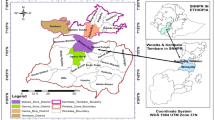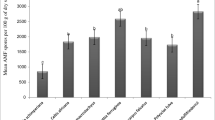Abstract
Natural occurrence of vesicular-arbuscular mycorrhizal (VAM) fungi in Haryana soils showed that VAM sporulation was more intensive in the rhizosphere of nonlegumes than of legumes. Maximum number of spores (342 spores per 50 g of soil) was observed in the rhizosphere of mustard, followed by chickpea, wheat, pearl millet and pigeonpea. Four VAM generaviz. Glomus, Gigaspora, Sclerocystis andAcaulospora, were present there. Soil pH, total soil P, available P, type of soil, soil moisture and cropping season all variables influenced the VA mycorrhizal population in the natural ecosystem. Numbers of VAM spores highly correlated with the presence of total soil P and soil pH indirectly affected the VAM population through the total soil P. The spore population was abundant in sandy soils as compared to loamy sands. Drier soils had higher number of VAM spores. In summer, the VAM population in soil was less as compared to winter season.
Similar content being viewed by others
References
Abbott L.K., Robson A.D.: Factors influencing the occurrence of vesicular arbuscular mycorrhizas.Agric. Ecosys. Environ.35, 121–150 (1991).
Bagyaraj D.J.: Ecology of vesicular arbuscular mycorrhiza, pp. 3–21 in D.K. Arora, B. Raj, K.G. Mukerjee, G.R. Knudsen (Eds):Handbook of Applied Mycology, Vol. 1. Marcel Dekker, New York 1991.
Dalal S., Hippalgoankar K.V.: The occurrence of vesicular-arbuscular mycorrhizal fungi in aerable soils of Konkan region of Maharashtra, p. 164 in B.L. Jalali, H. Chand (Eds):Current Trends in Mycorrhizal Research. Haryana Agricultural University, Hisar 1990.
Dalal S., Hippalgoankar K.V.: The occurrence of vesicular arbuscular mycorrhizal fungi in aerable soils of Konkan and Solapur, pp. 3–7 in A. Adholeya, S. Singh (Eds):Mycorrhizae: Biofertilizers for the Future. Tata Energy Research Institute, New Delhi 1995.
Deepika, Khurana A.L., Dudeja S.S.: Role of vesicular arbuscular mycorrhiza (VAM) in sustainable agriculture, pp. 37–45 in R.K. Behl, A.L. Khurana, R.C. Dogra (Eds):Plant Microbe Interaction in Sustainable Agriculture. Chaudhary Charan Singh Haryana Agricultural University, Hisar and Max Muller Bhavan, New Delhi 1996.
Dudeja S.S., Khurana A.L.: Persistance ofBradyrhizobium sp. (Cajanus) in a sandy loam.Soil Biol. Biochem.21, 709–713 (1989).
Gupta N., Ali S.S.: Incidence of vesicular arbuscular mycorrhizal fungi in Raipur soils, p. 24 in B.L. Jalali, H. Chand (Eds):Current Trends in Mycorrhizal Research. Haryana Agricultural University, Hisar 1990.
Gupta P.P., Chhabra M.L., Jalali B.L., Kumar P.R.: Influence of VA mycorrhizal inoculation on growth and development of rapeseed, pp. 135–136 in B.L. Jalali, H. Chand (Eds):Current Trends in Mycorrhizal Research. Haryana Agricultural University, Hisar 1990.
Gupta P.P., Chhabra M.L., Jalali B.L., Kumar P.R.: Growth response ofBrassica juncea to vesicular arbuscular mycorrhizal colonization, pp. 67–69 in D.J. Bagyaraj, A. Manjunath (Eds):Mycorrhizal Symbiosis and Plant Growth. University of Agricultural Sciences, Bangalore (India) 1991.
Gupta P.P., Chhabra M.L., Jalali B.L., Sabharwal P.S.: Biological control ofSclerotinia sclerotiorum by VAM inBrassica.Forage Res.20, 250–254 (1995).
Hiremath P.C., Harini Kumar K.M., Patil L.M.: Density of arbuscular mycorrhizal fungi in different crops grown under black soil, pp. 20–25 in B.L. Jalali, H. Chand (Eds):Current Trends in Mycorrhizal Research, Haryana Agricultural University Press, Hisar 1990.
John M.K.: Colorimetric determination of phosphorus in soil and plant materials with ascorbic acid.Soil Sci.109, 214–220 (1970).
Kendrick B., Berch S.: Mycorrhizae. Applications in agriculture and forestry, pp. 109–150 in C.W. Robinson (Ed.):Comprehensive Biotechnology, Vol. 4. Pergamon Press, Oxford 1985.
Khalil S., Loyanachan T.E.: Soil drainage and distribution of VAM fungi in two toposequences.Soil Biol. Biochem.26, 929–934 (1994).
Kianmehr H.: Vesicular-arbuscular mycorrhizal spore population and transfer of infection in some north eastern Iranian soils.Iranian J. Plant Pathol.26, 15–17 (1990).
Krishna K.R., Bagyaraj D.J.: Effect of vesicular-arbuscular mycorrhiza and soluble phosphate onAbelmoscus esculentus (L.)Moench.Plant & Soil64, 209–213 (1982).
Land S., Danck H., Von Alten H.: Evaluation of VA-mycorrhizae in different agricultural soil.Agric. Ecosys. Environ.29, 217–224 (1990).
Lopez-Sachoz M.E., Honrubia M.: Seasonal variation of vesicular-arbuscular mycorrhizae in eroded soils from Southern Spain.Mycorrhiza2, 33–39 (1992).
Methew J., Neeraj, Shankar A., Kaur R., Varma A.: VAM fungi from the rhizosphere of desert cacti, pp. 44–46 in B.L. Jalali, H. Chand (Eds):Current Trends in Mycorrhizal Research. Haryana Agricultural University, Hisar 1990.
Ocampo J.A., Martin J., Hayman D.S.: Influence of plant interactions on vesicular-arbuscular mycorrhizal infections. I. Host and non-host plant grown together.New Phytol.84, 27–35 (1980).
Olsen S.R., Cole C.V., Watanabe F.S., Dean L.A.:Estimation of available phosphorus in soils by extraction with sodium bicarbonate. Circ. 939. USDA Sup. of Documents US Govt. Printing Office, Washington 25 (DC) p. 19 (1954).
Singh J.P., Dahiya D.J., Kumar V., Singh M.: Distribution and status of different forms of nitrogen in soils of Haryana.J. Indian Soc. Soil Sci.40, 698–704 (1992).
Singh R., Pandya R.K.: The occurrence of vesicular arbuscular mycorrhiza in pearl millet and other hosts, pp. 3–7 in A. Adholeya, S. Singh (Eds):Mycorrhizae: Biofertilizers for the Future. Tata Energy Research Institute, New Delhi 1995.
Sulochana T., Manoharachary L.: Impact of season on the distribution of VAM fungi associated with sesame, pp. 16–17 in B.L. Jalali, H. Chand (Eds):Current Trends in Mycorrhizal Research. Haryana Agricultural University, Hisar 1990.
Talukdar N.C., Germida J.J.: Occurrence and isolation of vesicular arbuscular mycorrhiza in cropped field soils of Saskatchewan Canada.Canad. J. Microbiol.39, 567–575 (1993).
Trappe J.M., Schenck N.C.: Taxonomy of fungi forming endomycorrhizae. A. Vesicular-arbuscular mycorrhizal fungi (Endogonales), pp. 1–10 in N.C. Schenck (Ed.):Methods and Principles of Mycorrhizal Research. American Phytopathological Society Publication, St. Paul (MN) 1982.
Vardavakis E.: Mycorrhizae endogonaceae and their seasonal variations in a Greek sand dune.Pedobiologia36, 373–382 (1992).
Author information
Authors and Affiliations
Rights and permissions
About this article
Cite this article
Bhardwaj, S., Dudeja, S.S. & Khurana, A.L. Distribution of vesicular-arbuscular mycorrhizal fungi in the natural ecosystem. Folia Microbiol 42, 589–594 (1997). https://doi.org/10.1007/BF02815471
Received:
Revised:
Issue Date:
DOI: https://doi.org/10.1007/BF02815471




